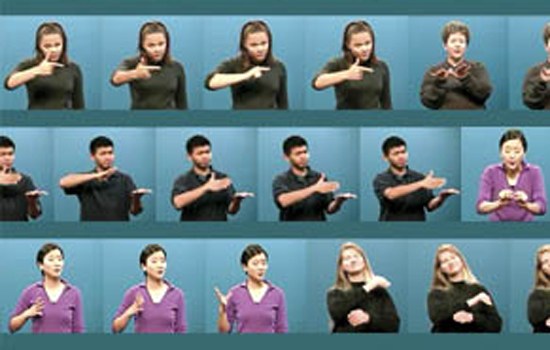Unique Sign Language Dictionary Now Available Online
Thousands of words, sentences and meanings are depicted
RIT’s National Technical Institute for the Deaf has developed the ASL Video Dictionary and Inflection Guide.
A popular sign language dictionary has recently been adapted for online use. RIT’s National Technical Institute for the Deaf has developed the ASL Video Dictionary and Inflection Guide. It is the first and only product that links thousands of signs to sentences illustrating how the signs change, or inflect, from sentence to sentence to show different meanings.
The CD version is used in thousands of schools, colleges, universities and interpreter training programs across the United States and Canada, and has now been updated. It is now available online by subscription for instant access by users.
The 2,700 signs and 650 sentences, all in color and signed by deaf native signers, show not only vocabulary, but a broad view of the entire language.
“The sentences demonstrate how signs change or inflect to convey different meanings,” said project director Geoffrey Poor, coordinator of Communication Assessment Services at RIT/NTID. “For example, ‘afternoon’ can be inflected to mean ‘early afternoon,’ ‘late afternoon’ or ‘all afternoon.’ The ability to see these inflections helps gain a true understanding of ASL, not just a list of its vocabulary.”
The program has many interactive features such as English translations of sentences and similar signs--signs that look alike - for easy comparison. There are various options for viewing the sentences: ASL first, English second; English first, ASL second; both simultaneously; and various default and replay options for order of presentation and signing speed. Also featured is a help file with password protection for socially restricted and substance abuse categories, preventing access by younger children.
A one-year subscription is $39.99 and may be purchased by visiting the ASL Video Dictionary, at dig@rit.edu, or by calling (585) 475-6282 (voice/TTY).
The project, done at NTID, was produced through an agreement between RIT and the U.S. Department of Education. Major assistance for this project was provided by Funds for Improvement of Postsecondary Education program, U.S. Department of Education. Additional funding was provided by the Carl and Lily Pforzheimer Foundation and the Gannett Foundation.




